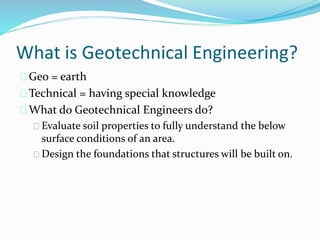The Ultimate Guide To Geotheta
The Ultimate Guide To Geotheta
Blog Article
Our Geotheta Diaries
Table of ContentsGeotheta - An OverviewTop Guidelines Of GeothetaThe Only Guide for GeothetaGeotheta Fundamentals ExplainedThe 30-Second Trick For Geotheta

They perform site investigations, gather examples, carry out research laboratory examinations, and analyze data to review the viability of the ground for building and construction tasks - Consulting Engineer. Based upon their findings, geotechnical engineers supply suggestions for structure style, incline security, keeping structures, and reduction of geotechnical risks. They team up with other professionals, such as engineers, architectural engineers, and building groups, to make certain that geotechnical considerations are integrated into the total task layout and application
By evaluating the habits and buildings of dirt and rock, they can determine prospective geotechnical threats such as landslides, dirt settlement, or slope instability. Their experience helps avoid failures or accidents that could jeopardize lives and residential or commercial property. Here are some comprehensive duties and duties of a geotechnical designer: Site Examination: Geotechnical designers conduct site investigations to collect information on subsurface conditions.
They translate the information to understand the residential properties and behavior of the dirt and rock, including their strength, permeability, compaction attributes, and groundwater problems. Geotechnical Evaluation and Style: Geotechnical engineers examine the information collected during website investigations to examine the security and viability of the website for building and construction projects. They carry out geotechnical computations and modeling to review factors such as bearing capacity, negotiation, incline stability, side planet stress, and groundwater flow.
The Geotheta Statements
Structure Design: Geotechnical designers play a vital duty in designing foundations that can securely sustain the designated structure. They evaluate the soil conditions and lots demands to determine the ideal foundation type, such as superficial structures (e.g., footings), deep structures (e.g (https://anotepad.com/note/read/ew8kqmw7)., heaps), or specialized techniques like soil enhancement. They think about elements such as settlement limitations, birthing capacity, and soil-structure interaction to create optimum foundation styles
They examine construction strategies, display website activities, and perform field inspections to validate that the design referrals are complied with. If unexpected geotechnical problems emerge, they examine the scenario and offer referrals for removal or adjustments to the style. Danger Assessment and Reduction: Geotechnical engineers examine geotechnical dangers and dangers linked with the job website, such as landslides, liquefaction, or dirt erosion.

Partnership and Communication: Geotechnical designers work carefully with other professionals associated with a project, such as architects, architectural designers, and building teams. Reliable communication and collaboration are important to integrate geotechnical factors to consider into the total job layout and building process. Geotechnical designers supply technical competence, answer questions, and guarantee that geotechnical demands are fulfilled.
Some Known Incorrect Statements About Geotheta
Below are some sorts of geotechnical engineers: Structure Engineer: Foundation engineers focus on designing and analyzing foundations for structures. They assess the soil conditions, lots needs, and site qualities to determine one of the most appropriate structure kind and layout, such as superficial structures, deep structures, or specialized strategies like stack foundations.
They review the elements influencing incline stability, such as soil homes, groundwater conditions, and incline geometry, and develop approaches to avoid slope failures and mitigate risks. Earthquake Engineer: Quake designers focus on examining and creating frameworks to hold up against seismic pressures. They analyze the seismic hazard of a site, evaluate dirt liquefaction possibility, and develop seismic layout standards to make certain the security and strength of frameworks throughout earthquakes.
They carry out field testing, collect examples, and evaluate the gathered information to characterize the dirt buildings, geologic developments, and groundwater problems at a site. Geotechnical Instrumentation Engineer: Geotechnical instrumentation designers focus on tracking and determining the habits of dirt, rock, and structures. They mount and preserve instrumentation systems that keep track of variables such as dirt negotiation, groundwater levels, incline activities, and structural variations to examine performance and give early warnings of possible issues.
About Geotheta
They conduct tests such as triaxial tests, combination examinations, straight shear examinations, and leaks in the structure tests to collect information for geotechnical analysis and layout. Geosynthetics Designer: Geosynthetics designers focus on the style and application of geosynthetic products, such as geotextiles, geogrids, and geomembranes. They use these materials to improve soil security, reinforce inclines, offer water drainage solutions, and control erosion.
They often tend to be investigative individuals, which suggests they're intellectual, reflective, and inquisitive. They are curious, systematic, sensible, analytical, and rational. Several of them are additionally social, indicating they're kind, charitable, cooperative, person, caring, valuable, compassionate, sensible, and pleasant. Does this seem like you? Take our totally free profession test to discover out if geotechnical engineer is one of your top profession matches.
In the workplace setting, geotechnical engineers use specialized software program tools to carry out computations, produce layouts, and examine information. They prepare records, Engineer of Record evaluation project specifications, communicate with customers and staff member, and coordinate job tasks. The workplace setting provides a conducive atmosphere for research, analysis, and collaboration with various other experts included in the project.
Some Known Facts About Geotheta.
They frequently see project sites to conduct site examinations, examine geotechnical problems, and collect information for evaluation. These sees include taking a trip to different areas, in some cases in remote or tough terrains. Geotechnical designers may do soil tasting, conduct tests, and display building tasks to make sure that the geotechnical elements of the project are being implemented appropriately.
Geotechnical designers likewise work in specialized geotechnical research laboratories. Geotechnical laboratory engineers work extensively in these settings, handling testing equipment, operating instruments, and tape-recording data.
Report this page